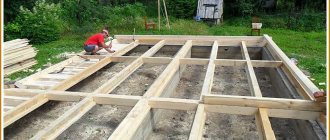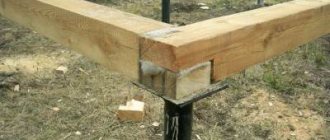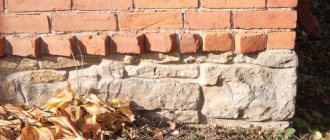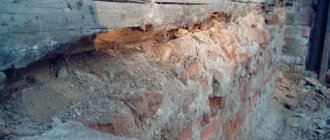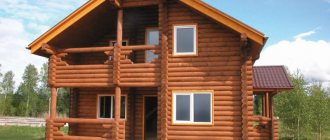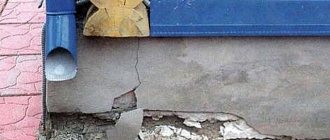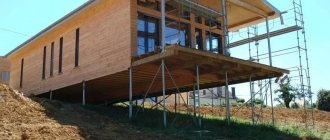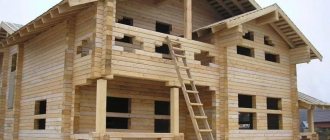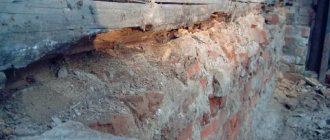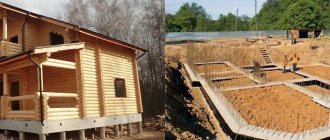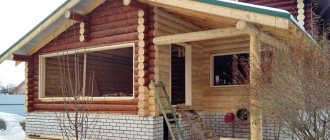Wooden houses are still popular today. But after several decades of operation, they require a major overhaul, which is based on replacing the lower rows of logs that have been negatively affected by moisture and rotted, or on raising and strengthening the foundation.
In order to repair a log house without any problems, it needs to be raised.
Narrative plan:
- What buildings can be lifted;
- When wooden houses are raised;
- Preparatory work stage;
- What is required to lift a wooden house;
- Stage of raising housing construction.
House lifting technology
It is possible to raise a house without the use of special equipment; in this case, you will need to use hydraulic jacks that can handle a load weighing 10 tons. In order to dismantle the foundation, you should use a sledgehammer, a crowbar, and also dismantling wedges.
Timbers, massive chocks and bricks can serve as temporary supports. And the boards will become spacers. The platform for installing the jack will be beams and boards, which should be combined into a shield; if such material is not available, you can use any other that is durable. A steel plate, the minimum thickness of which should be 5 mm, will evenly distribute the forces exerted by the jack rod on the first crowns of the building. If work will be carried out with a foundation on supports with a back-up, the latter must be dismantled
At the preparatory stage, it is important to rid the building of heavy things and furniture. Moreover, the floor must also be disassembled. In order to raise the house onto the foundation, jacks should be installed on both sides at a distance of 0.5 meters from the corners
If the jacks are installed correctly, they will handle the lift. Errors when placing jacks can cause deflection of the beams, which are part of the lower frame, which will lead to uneven lifting, separation of the logs and their breakage. Before raising the house, you need to make sure that the jacks are located in places where the wood has not been exposed to rotten influences
In order to raise the house onto the foundation, jacks should be installed on both sides of it at a distance of 0.5 meters from the corners. If the jacks are installed correctly, they will handle the lift. Errors when placing jacks can cause deflection of the beams, which are part of the lower frame, which will lead to uneven lifting, separation of the logs and their breakage. Before raising the house, you need to make sure that the jacks are located in places where the wood has not been exposed to rot.
It is necessary to install gaskets, which can be steel plates, this will facilitate the correct transfer of forces to the bars from the jack rod. It is permissible to replace the plates with pieces of wood. Jacks should be installed on a prepared site; if necessary, they should be deepened into the soil, which will ensure their more reliable stability.
Concrete is first poured into the formwork and then compacted.
Sections of beams that are used in the process of arranging temporary supports should be used in such quantities as the lifting technology will require. If you intend to lift the entire house at once, the number of supports should be 2 times larger. The support should be assembled using sections of beams; ultimately, the support should take the shape of a well.
The supports must be given a height that is 10 cm greater than the difference in distance from the height of the jack to the ground. This is explained by the fact that during the lifting process the supports will settle, pressing into the soil. The technology involves lifting houses from both sides simultaneously, the lift on each side should be uniform, but at one time it should not exceed 1.5 cm. The result obtained must be immediately recorded using temporary supports.
Lifting can lead to kinks in the first rims, which indicates the need to install additional jacks. At this stage, it is necessary to ensure that the building does not move to the side, because then this will cause a change in the center of gravity.
In order to replace the foundation, the building will have to be raised to a height of at least 6 cm. Afterwards, the building can be lowered onto scraps of logs, which need to be placed on temporary supports.
After the house has been raised to the required height and secured with temporary supports, dismantling of the old foundation should begin. To do this, you will have to disassemble the rubble and brickwork using chisels, but you can use any tools that are convenient. Old supports must be removed from the ground by rocking them to the sides. Some materials that have been well preserved can be used in arranging the future foundation.
The fundamental structure is the support of a residential building, the destruction of which entails negative consequences. Old houses made of wood or panel material are lifted with a special device and a new foundation is formed. The construction of residential buildings without foundations is the choice of European developers. In the domestic space, this technology is just beginning to be developed and implemented. Therefore, most repairs involve raising a wooden house with your own hands.
Lowering the frame after repairing the foundation
When the restoration work is completed, the building must be properly lowered into place. In order not to damage the frame, the jack is also moved gradually: the reverse work is performed. A jack is installed, a support is removed, after which part of the building is lowered a little, a temporary support is placed, and you can move to the next point.
It is important not to rush: it is very easy to damage the structure, but repairs will be extremely difficult. Work on raising a log house should not be carried out alone; it is better to first consult with experienced builders.
So gradually the house rises onto its supports. Now you can repair (or build a new) foundation. We recommend watching a video on the topic.
Lifting to the foundation
It remains to consider how to raise a house from timber onto a foundation. After the foundation is ready and has gained its strength, the house continues to be raised to build the basement, relying on a new foundation and the same jacks. Watch the training video:
After all repair work is completed, the house is gradually and smoothly lowered, performing the work in the reverse order: jacks are brought in and lintels are removed until the walls rest on a new foundation.
We regularly publish useful content about building houses -
Like and subscribe to the channel!
Source: zen.yandex.ru
Instructions for raising a wooden house
If there is only one jack, the corners of the house are lifted one by one, placing the bars
You can lift a building with one or more tools. In the first case, the power of the jack should reach at least ¼ of the weight of the building. The lifting capacity of multiple lifts will be less.
Different technologies are used for this:
- If there is only one jack, the house is lifted one by one. The tool is installed at the corner of the building, raised no more than 5 cm and a beam is placed. Then they pull it out, set it at a different angle (not the opposite, but on the same side) and repeat the operations.
- 2 jacks are placed on both sides of the corner. It is impossible to hang both sides at once; each corner is raised in turn. Otherwise, the house moves and its walls become deformed.
- If 4 jacks are used, the corners of the building are still lifted one at a time. But since the tool does not need to be pulled out and installed in a new place, the process takes a minimum of time.
Otherwise, the technology is the same and includes the following steps.
- Determine the lifting height. If you need to repair a columnar foundation, you will have to dismantle the old one and replace it with screw piles. If it is only necessary to increase the foundation, the building is raised only slightly above the new foundation level.
- It is safest to use 2 jacks to lift 1 corner. The instruments are placed on both sides at the same distance. Places are chosen carefully: the tree in this area must withstand heavy loads, so it must be durable, without rot or mold.
- Raise the angle by 2–5 cm. Then lay a beam or brick, creating temporary support. It is recommended to install supports not only at the angle itself, but also along the wall being raised every 1.5–2 m.
- The building can only be moved vertically. After each lift, the position is checked with a plumb line.
- The jacks are pulled out, installed near the next corner and the actions are repeated.
- When the house is raised to the desired height, repairs or replacement of the foundation begin.
The nature of the repair depends on the causes of the destruction. If a frame house on a columnar foundation warps, it is better to replace it with a strip foundation - dig trenches, install formwork and fill it with concrete. If the damage is not so great, it is recommended to reinforce the existing structure.
Often the cause of damage to an old foundation is poor-quality concrete. In this case, the base needs to be replaced: smash the old structure with a sledgehammer, remove all the remains, deepen the trench if necessary and use concrete of the appropriate class for pouring.
How to raise a house with your own hands - detailed instructions
To lift a house with a jack, a different number of lifting devices can be used depending on their availability and the weight of the structure:
- use of one lift.
When moving various points of the building one by one, it is important to make a vertical displacement of no more than 5 cm in one cycle. This will avoid irreversible deformations, which can result in skewed doors, cracking of the finish and damage to the integrity of the glass. The raised area is fixed with bars, and the jack is moved to the next area. Performing operations allows you to consistently raise the house to the same level; - use of two lifting devices.
Vertical movement devices should be positioned correctly and both points should not be hung simultaneously. Each section is lifted in turn, which prevents the building from moving in the direction opposite to the lifts and being seriously deformed. The lifting algorithm using two devices is similar to the previously discussed option; - synchronous operation of four devices.
The use of equipment installed in the corner areas of the building makes it possible to lift a wooden structure as efficiently and safely as possible, moving 2–4 cm at a time. It is important to ensure synchronization to ensure smooth movement by giving a voice command to the workers. It is possible to use professional equipment equipped with a synchronous control system.
Place the jack on a strong wooden board, and between the head of the jack and the log against which it will rest, place a steel plate with a recess for the head
The step-by-step methodology recommends performing jacking activities, following the sequence of operations:
- Determine the lifting pattern and the location of lifting devices.
- Compact the soil where the jacks are located.
- Place larger supports under the lifting device.
- Form a support plane using plates in the rod contact area.
- Lift each section to a height of no more than 2–4 cm in one cycle.
- Install, if necessary, fixing pads.
- Carry out work by controlling the position of the house with a level and ensuring its uniform movement.
- Place powerful stops in the work area to ensure that the structure cannot be lowered in the event of an accidental failure or breakdown of the lifting device.
If it is necessary to ensure synchronous movement of lifting mechanisms located on opposite sides of the building, use a metal beam located under the building and supported by rods.
Preparatory work, necessary materials and tools
At the preparatory stage, it is necessary to inspect the building, assess the degree of complexity and duration of the planned repairs, determine the method of lifting, and carry out work to protect the structure from destruction during movement.
If there are problems with the foundation, there are two options - build a new house or try to restore and replace it
The need for repairs by lifting a wooden building is indicated by visual signs:
- significant skew or tilt of the house;
- the appearance of a network of cracks on the interior and exterior finishes;
- local or complete subsidence;
- deepening part of the foundation into the ground;
- significant violation of the integrity of the foundation.
The vertical movement of the structure is carried out to carry out the following types of activities:
- Performing partial or major repairs of the foundation.
- Preventing subsidence of the structure.
- Replacement of rotted support beams around the perimeter of the building.
- Alignment of box distortions.
- Carrying out protective treatment of wood.
- Eliminating mistakes made by builders.
Most often it is necessary to raise a wooden house when problems arise with the foundation
In order to determine the method by which the house will be raised using special devices, the following factors are analyzed at the preliminary stage:
- mass of the building. Each jack must provide a 40% lifting capacity. To do this, the total weight of the structure is calculated by multiplying the cubic capacity of the box by the specific gravity of wood equal to 0.8 t/m3. The weight of the floor, roofing and finishing is added to the resulting number;
- dimensions of the building box. With a building length of more than six meters, there is a high probability of beams or logs subsiding in the splice zone. Additional installation of supporting elements at the joining areas will be required;
- presence of internal lining. Using plasterboard sheets or plaster to decorate walls indoors complicates the implementation of activities. Installing 50 mm thick boards on the outside of the corners will avoid repeated repairs indoors;
- soil features. Depending on the structure of the soil on which the lower plane of the lifting device will rest, it may be necessary to use concrete blocks or special panels of increased area. This will prevent the jack from sinking;
- travel height. The length of the working stroke of the rod is limited by the design of the lifting device. The use of special pads made of durable square-section timber with a side size of 100–150 mm will allow you to gradually achieve the required moving height;
- duration of repair activities. The duration of the repair is determined by the degree of complexity; if it is carried out for a long time, it is undesirable to rest the structure on the rod. It is advisable to use temporary structures made of metal and wood that have sufficient supporting area.
Sometimes a bad site is chosen to build a building, then they put a new foundation in another place and drag the house
Raising the house to the height required for repairs can be carried out using the following equipment:
- By crane.
It is used mainly for the purpose of lifting to move buildings to another site. - Powerful jacks.
A widespread method of moving wooden buildings in a vertical plane.
When planning to raise a house on jacks, you should prepare:
- cut off the power supply;
- turn off the gas supply;
- shut off water mains;
- turn off the sewer system;
- ensure free movement of a stove installed on an independent foundation through the roof of the chimney;
- disconnect the individually mounted boiler from the heating pipes;
- dismantle the floor in the area of the stove and heating boiler;
- secure the immobility of the box with steel plates screwed to the corners.
Use a jack to lift the frame slightly. Only 2-3 cm at a time
Where would you prefer to live: in a private house or apartment?
To complete the work you will need the following materials and tools:
- Hydraulic type jack with a lifting capacity corresponding to the design value.
- Support panels made of wood, allowing to reduce the load on the ground when installing lifts.
- Set of metal pads measuring 20–30 cm.
- Grinder equipped with a disc.
- A set of tools for detaching the support beam around the perimeter of the building.
Jack selection
To lift the building, you will need 4 jacks, the load on which will be distributed evenly.
When choosing a jack, you must correctly calculate the weight of the house. The result obtained is divided by 4. When lifting a small house, you need to have a reserve of half the mass. On small structures, only 4 lifting mechanisms are installed in the corners. For larger ones they are installed more often.
After calculating the masses, the type of mechanism that is suitable for the designated purposes is determined. The jack for lifting a wooden house at a short distance from the installation point to the crown must be inflatable or rolling. If the distance from the lifting point to the ground is more than 30 cm, bottle and scissor hydraulic lifts are suitable.
The weight of the building is calculated based on the weight of worn round logs - 700-800 kg/m³. The volume is calculated in m³. It includes all walls, ceilings, partitions. The weight of all property not removed is added.
Preparing to lift the house
In order for the result to be of high quality, it is recommended to use professional services - specialists with equipment. Working independently without understanding the key points is dangerous. Preparation for lifting includes the following steps: 1. Selection of a new foundation based on the results of soil assessment, the level of freezing of soil and groundwater. For heavy, several-story log houses, a poured strip version is used. Screw piles are suitable for light timber buildings. To come to the right decision, you should contact the geodetic department of the area, where everything is known about the nature of the soil.
Preparing the bottom frame of the wall
In order for the house to withstand the rise without destruction, it is important to check the condition of the lower frame in order to identify its weakness. If the log is rotten or dry, it must be replaced or dismantled before installing the jacks. You can make a cut under the lifting mechanism to a whole log through the defective one.
In general, before starting work, you should check the entire lower tier: tap it, identify weak logs. To this end, you may need to hire a professional to accurately diagnose the condition of the walls.
We are preparing to strengthen the foundation of a private house
At the preparatory stage of work you should:
- assess the condition of the base;
- carry out preventive work;
- choose the right repair method.
Please note the following points:
- material used;
- compliance with masonry technology;
- number of problem areas;
- depth of cracks;
- condition of concrete.
A dilapidated foundation will become stronger if it is surrounded by a new reinforced concrete tape firmly connected to it
The method for diagnosing the condition of the foundation involves performing the following work:
- Gluing paper beacons to cracks. The sticker must be applied perpendicular to the crack, ensuring maximum tension on the paper.
- Visual check of the integrity of control elements. Tearing of the paper indicates increasing damage and the need for reinforcement.
Before carrying out work to strengthen the problem base, the following types of preventive measures can be performed
:
- lay drainage. It will reduce soil moisture and avoid problems associated with subsidence;
- insulate the foundation. High-quality insulation will protect against destruction caused by deep freezing of the soil.
Perform drainage installation following the given algorithm:
- Extract the soil along the contour of the house to the groundwater level.
- Dig a drainage well away from a residential building.
- Lay pipes from the drainage ditch to the well.
- Lay geotextiles on the bottom of the pit.
- Pour a layer of crushed stone and lay drainage pipes.
- Connect the drainage to the drain line.
- Fill the pipes with crushed stone and fill the pit with drainage mixture.
The work of renewing the foundation under a building is labor-intensive, but not as impossible as it may seem
When installing thermal insulation, follow the sequence of operations:
- Dig a pit along the contour of the house.
- Place a layer of sand on the bottom.
- Place sheets of polystyrene foam on the sand bedding.
- Assemble the panel formwork in the trench.
- Hammer the pins into the masonry and install the reinforcement cage.
- Fill with M300 concrete mortar.
After performing preventive maintenance, you should decide on the repair technology.
Raising a building using jacks - precautions
Compliance with safety requirements when performing work is mandatory. Pay special attention to the following points:
- mandatory strengthening of the box with thick boards;
- installation of spacer beams in door and window openings;
- ensuring the immobility of the jack location;
- checking the strength and strengthening of wood in the area where the support rods are located;
- use of special steel thrust bearings.
By lifting and ensuring the structure is stationary, you can safely carry out repair work
Following the recommendations of professional builders, you can independently jack up the house to carry out repairs of varying levels of complexity. If you lack the necessary experience and self-confidence, it is advisable to entrust the work to professionals who will perform it with the utmost care. Compliance with technological recommendations will ensure smooth lifting and protect the structure from unexpected damage.
Source: pobetony.ru
Replacing a structure with raising the house
Laying the foundation in this way will require the presence of powerful pneumatic jacks, which are brought under the corners of the log house and lifted. Lifting begins from the most damaged corner and is performed gradually, no more than 2-3 cm in one action.
As the house moves up, wooden planks are placed under the crowns. The house is leveled horizontally, installing additional supports around the perimeter.
Having raised the frame to a height of at least 20 cm, the replacement begins. The work consists of the following stages:
- Dismantling the base. Destruction begins from the corners, then all parts of the old structure are removed.
- Digging a trench, laying a sand and gravel cushion on the bottom.
- Pouring the pillow with concrete. Layer height – 15-20 cm.
- Laying a reinforcing belt in a trench. The reinforcement is placed in the trench 3 days after pouring the sand and gravel pad, when the concrete layer “sets.”
- Installation of formwork, pouring concrete using standard technology. The filling process is carried out continuously. Often, inexperienced developers use stage-by-stage pouring, which causes the concrete to form many seams and lose strength.
- The house can be lowered when the concrete has completely hardened, no earlier than after 20-30 days. Concrete gains its final strength 40 days after pouring. The procedure for lowering the log house is carried out as gradually as raising it was carried out.
Technology and stages
First you need to move all the furniture from the house and prepare for the fact that the work to replace the foundation will take at least 6 weeks, depending on the rate of hardening of the concrete solution.
The work is divided into several stages.
Installation of jacks. They must be located in a continuous area of the base and used at a uniform speed to avoid damage to the crown of the house. Raising the building. It is necessary to raise the walls 6 cm higher and remove dilapidated elements. It is first necessary to make supports from the beams, treating each with an antiseptic. In place of the new foundation you need to fill 10 cm of gravel
It is important to raise the structure gradually: no more than 2 cm at a time on each side. After each lift, it is necessary to fix the position of the house using log supports.
- Removing old material. Damaged masonry is dismantled using a crowbar and chisel. If the foundation has retained its integrity in some places, then it is left.
- Installation of a new foundation. First of all, you need to prepare a trench, the depth of which will be greater than before. A sand cushion is poured onto its bottom, then a reinforcement frame and formwork for waterproofing are constructed.
After this, you can begin pouring the concrete solution. It will harden in about 2 weeks. After this time, boards and temporary supports are placed on the first section of the base. The frame of each subsequent section is connected using reinforcement.
The final stage of the work will be the installation of the house on a new foundation. The fixing temporary beams are removed.
It is necessary to follow the rules and the sequence of stages of work - then you will be able to properly repair or replace the foundation under a wooden house.
To learn how to replace the foundation of a sagging wooden house, see the following video.
Types and types of foundations for wooden buildings
At the moment, the following types of foundations for a wooden house are distinguished:
- tape;
- columnar;
- pile;
- slab.
Strip foundation
The tape design is the most widespread today. It can be divided into the following groups:
- Recessed.
- Shallow.
- Not buried.
The construction of a buried strip foundation is relevant if the depth of soil freezing is significant, groundwater is very close to the surface, or the structure will have a basement, ground floor or garage.
Shallow construction is best suited for wooden houses. This is explained by the fact that the weight of such buildings is much less than brick ones. The height for a wooden house above the ground varies from thirty to fifty centimeters. For this reason, it is used in situations where it is necessary to save on the foundation without losing its quality.
A shallow foundation is suitable for small wooden buildings or those that are needed only temporarily.
The process of constructing a strip foundation can be represented in the following stages:
- Digging a pit. The depth of the foundation of a wooden house must necessarily be greater than the depth of soil freezing (about twenty centimeters). As for the width of the pit, this value is equal to the width of the foundation, to which half a meter is added for formwork and ease of work.
- Creating a cushion from sand and cement. A mixture of sand and cement is placed at the bottom of the pit. The thickness of the layer should be at least fifteen centimeters, and preferably twenty centimeters. The mixture must be compacted: to do this, it is first watered with plain water and then compacted. The purpose of the sand-cement cushion is to reduce the load on the structure.
- Creation of formwork. In order for the surface of the structure to be as smooth as possible, the formwork must be knocked down from the inside, and nails must be driven in from the outside. Following this advice will also make dismantling the formwork easier.
- Installation of spacers.
- Laying of reinforcement. Under no circumstances should elements be connected to each other by welding: only wire can be used.
- Pipe laying. They are necessary for communications.
- Pouring concrete.
Columnar foundation
Columnar foundation
This design is suitable for soil with a serious freezing depth, which at the same time regularly swells. Also, this foundation can be used on uneven terrain.
The construction of a columnar structure involves the use of concrete blocks, bricks and asbestos pipes. Therefore, it is not suitable for buildings with a basement or ground floor.
The technology for constructing a columnar foundation is as follows:
- The location where the pillars will be installed is determined. Despite the fact that the distance between them is determined by the size of the house, it should not be less than one and a half meters.
- Installation of pillars. They go deep into the ground by approximately 50 - 70 cm. In this case, a sand-cement cushion must be made under each of them.
Pile foundation
Such houses are built in areas with uneven terrain or when the soil is unstable. It is also suitable in situations where the groundwater level is high or changes frequently.
The pile structure is constructed in almost the same way as a column structure. The only difference is that the elements in this case are not simply driven into the ground, but are screwed into place. This is possible due to the fact that there is a drill at the end of each pile.
Slab foundation
A slab foundation is indispensable for moving soil. The construction of this foundation involves the production of a monolithic concrete slab with reinforcement. Its area exactly matches the area of the house. One of the advantages of such a slab is that it is movable, so the house is not damaged when the ground moves.
The slab foundation is erected as follows:
- First, a pit is dug out. Since it will be large in size, it will most likely not be possible to do without the use of special equipment.
- Creating a pillow from cement and sand.
- Laying of reinforcement.
- Pouring concrete.
Installing a slab foundation is not an easy task. The main difficulty of this work is to achieve uniform drying of the concrete over the entire surface of the slab. Therefore, if a tiled foundation is the only possible option, then it is best to seek help from a specialist.
General information
But the topic of this note is not how the two technologies differ and which will be better. At one time, there was quite a lot of debate on forums about the fact that the platform is inconvenient specifically because in order to lift a very heavy piece of wall and put it in a vertical position, it is important to involve several people.
In fact, when building from a dry board, a couple of people can easily lift a 6-meter wall (if it was not covered with slabs). It turns out that 2-3 people are usually enough so that the issue of raising the walls when lining up along the platform does not worry you. And yet, sometimes it happens that there are no assistants nearby, or the wall is much heavier (longer, or lined with heavy slabs, etc.). in this case, the following type of device will come to the rescue.
Required tools and materials
The main reasons for the loss of structural strength include changes in groundwater levels and precipitation. The peculiarities of buildings made of lumber lie in their lightness and the method of arrangement. It is quite possible to build your house on a replaced foundation; the main thing is to set a goal and purchase the necessary materials. To make a foundation for an old wooden house, you may need the following tools and materials:
- concrete mixture (cement, sand, crushed stone or gravel of medium fraction);
- steel rods for foundation reinforcement;
- wooden formwork;
- jacks;
- shovel;
- large sledgehammer;
- scrap steel;
- wedges
Using these materials, it is easy to independently raise an old house and build a new foundation underneath.
What buildings can be raised
Using modern technological techniques, one-story wooden buildings can be easily jacked up. The materials used for such buildings are:
- rounded logs;
- square and rectangular beams;
- prefabricated panels covered with planed boards or slabs.
The small size and weight of wooden buildings make them easier to move.
It is necessary to carefully prepare for the process of lifting a house with a jack and learn all the intricacies of the technology.
Types of foundation deformation
In addition to finding out the reasons that led to the destruction of the foundation, it is necessary to give an adequate assessment of its extent. This will allow us to determine the possibility of strengthening the foundation and the feasibility of this event. Maintainability is determined in accordance with the following criteria:
1. Damage is minor
This includes violating the integrity of the foundation finishing. The presence of phenomena of this kind does not affect the strength of the foundation and does not reduce its bearing capacity. Eliminating them is easy.
2. The damage is moderate
The occurrence of cracks is associated with the process of subsidence or destruction of the base. Before starting work, it is necessary to differentiate the nature of the cracks. Their horizontal arrangement poses less danger compared to vertical or zigzag
In addition, it is important to find out what the nature of the process of foundation subsidence is. That is, this phenomenon is temporary or progressive. Average damage
Average damage
To clarify this circumstance, beacons are used. Plain paper can be used as them, but there is a risk of it getting wet. The use of plaster plasters is recommended. The simplest method involves applying a small amount of putty to the surface. Then, using a spatula, a mark is made in the form of a straight line. Even a slight shift of the tested surface will be noticed. In addition, when using this method, you can find out at what speed the destruction process occurs.
Temporary subsidence will not be detected by beacons. In this case, most likely, some shift of the soil located under the foundation occurred, it was fixed in a certain position and the probability of further movement is low. Therefore, to eliminate defects, it is sufficient to carry out routine repairs.
When lighthouses are destroyed, it can be argued that the destruction process is progressing. Sealing cracks will not give the required effect, since the deformation is close to catastrophic.
3. The damage is catastrophic.
The presence of defects of this kind can cause destruction of the structure. Timely work to strengthen the foundation will prevent extremely negative consequences from occurring. However, in practice there are situations in which this opportunity is missed.
The choice of technology depends on the type of foundation. In this case, each specific case considers its strengthening or replacement.
4. It is not possible to eliminate deformations
The condition of the foundation is so poor that repairs are impractical. In such situations, the most correct solution is to demolish the building. From an economic point of view, dismantling a house is much cheaper and simpler than measures to strengthen the foundation. The construction of a new cottage on the site of the previous one in accordance with building codes and regulations will allow you to have comfortable and safe housing.
Sometimes the only right solution is to demolish the building
Hydraulics: features, advantages and requirements
The hydraulic type of lifts differs in design (single and double plunger jacks) and type of drive (manual intermittent action or electric continuous action). You should definitely take an electro-hydraulic jack with you if you plan to travel long distances, but before purchasing you should familiarize yourself with its drawing, functions and main components.
In order for a hydraulic transmission jack to function optimally, it needs a liquid, for which experienced specialists recommend using machine oil. Due to the unique design of the ratchet, heavy loads can be lifted to great heights. Hydraulics should be used to repair cars in the garage, and its advantages include the following:
- sustainability;
- smooth operation;
- accuracy of vehicle installation at the required level;
- ease of use and high load capacity, due to which you can even pull trucks.
Note! It is strictly forbidden to leave the car on a jack during operation, even if it is the most reliable and stable one. For these purposes, you need to use special supports, which are often wheels or logs.
Hydraulic jack. Before purchasing hydraulics, you need to familiarize yourself with its disadvantages, which include the large weight and dimensions of the device, due to which it will be inconvenient to carry it in the trunk
You also need to ensure that there is no oil leakage, and use only one position to store the jack
Before purchasing hydraulics, you need to familiarize yourself with its disadvantages, which include the large weight and dimensions of the device, due to which it will be inconvenient to carry it in the trunk. You also need to ensure that there is no oil leakage, and use only one position to store the jack.
As for the pick-up height of the mechanism, it must correspond to the vehicle’s ground clearance, which is the distance from the surface of the earth to the bottom of the car. Hydraulics have a large lifting height, so they are not suitable for repairing passenger cars with low ground clearance (only if it is possible to lift the car first). Popular hydraulic jacks are represented by rolling and bottle mechanisms.
Preparatory work
The preparatory work stage occupies an important place in the process of building a house. First of all, it is necessary to clear the area of construction debris, cut down excess trees and uproot stumps, remove dry grass
Preliminary zoning of the site will allow you to effectively use every corner during operation. It is best to level the surrounding area before starting construction work and laying the foundation. This will not only give the site an attractive appearance, but will greatly facilitate construction work at all stages. The terrain with large differences requires stepwise leveling of the territory.
Next, the exact location of the house is determined and the foundation is marked. To do this, pegs are installed in all corners of the future building. If the house is a standard rectangular shape, the result should be a figure with perfectly equal angles of 90°. If the angle is not maintained, it is necessary to achieve this result by moving the limit cord in one direction or another.
Along the future walls, at the same distance from each other, pegs are also installed and a rope or cord is pulled between them. The diagonals drawn between the corners of the building must be exactly equal to each other.
An example of checking angles in markings - if the diagonals are equal, then all angles are 90°Source homeframe.ru
When marking for a strip foundation, it is necessary to retreat from the walls of the house at a distance equal to the width of the foundation. Most often this figure is no more than 20 cm.
You can dig a trench either by hand or using specialized equipment. It is formed at least 20 cm below the freezing point of the ground, characteristic of the area in winter. It is necessary to dig a trench strictly following the markings and forming a flat bottom.
Installation of jacks and their correct position
Before replacing the foundation under a wooden house, you should understand how to properly install jacks. They are installed under the lower log, placing a board or timber under them for greater strength.
Moreover, it does not matter whether the jack rests on the ground or a concrete surface, a lining must be provided to give the device better stability
A steel plate of approximately 10x10 cm is placed under the head. The place on the log where it will rest is also treated, making it as even as possible
It is also important to monitor the level of the hydraulic device - it must be positioned strictly vertically. At the slightest tilt, work is stopped and the jack is restored to its original position.
To control the height of the rise into the ground, a rail with markings on it is installed at one of the corners of the building. Similar marks are applied to the corner itself. During the lift, based on the difference in indicators, the actual lift height is determined.
How to choose a method of raising a house?
To raise a log house correctly, you need to consider the following factors:
- weight of the building;
- the length of the walls and the overall dimensions of the house;
- type of building (frame, timber);
- the duration of operation of the old house, the condition of its foundation;
- soil structure under the foundation;
- type of house foundation, materials used (stone, wood, concrete);
- the purpose of raising the building.
If the entire foundation is affected, then it is necessary to raise the house completely. If you can get by with replacing only one part, then there are ways to partially raise it.
Builders have the following methods at their disposal to lift the structure:
- using a crane (used if the house from the log house needs to be moved to another location);
- using ropes that move under the structure (the method is optimal for light-weight and small-sized structures);
- using a jack (a universal method recommended for different types and dimensions of the building).
How to determine the lift height?
In order to easily and accurately control the step height when lifting the corners of a building, it is necessary to install a rail with a pre-marked mark. It also needs to be moved to the corner of the building from the log house. When the house begins to rise, the mutual movement of the two marks will indicate the step height.
The jack rod is not suitable for measuring the lifting height. It gives inaccurate readings due to possible subsidence under the pressure of the structure. When lifting, it is necessary to control the position of the mechanism. If even the slightest deviation is noticed, work must be stopped and corrected.
What houses can be raised and why do it?
In a wooden house, the lower logs usually need to be replaced due to rotting.
A feature of the operation of wooden log structures and country houses made of timber is the periodic repair of the lower part of the building. Over the course of many years of operation, the lower crowns fail and rot. Periodic replacement of the first rows is beneficial for hardwood buildings. Oak and larch can stand for centuries and only a rotten foundation will threaten to collapse.
Also, jacking is a necessary condition for replacing a worn-out foundation, moving a wooden building, and installing it on piles.
Only one-story buildings made of logs, timber or frame structures are allowed to be lifted with a jack for repairs.
It is recommended to replace the lower crowns in increments of 15-20 years. Modern buildings are more susceptible to rotting due to poor ecology and insufficient preparation of the forest during construction.
Sequencing
First, it is worth assessing the condition of the building and especially the lower crowns. If the outside of the log house is lined with clapboard, it is removed and an awl is stuck into the beam or log. If it goes in easily, then the wood is damaged and will need to be replaced. This means you buy a beam of a suitable cross-section (even if the frame is made of logs), tape for compaction, and antibacterial impregnation for wood in contact with the ground. You process the timber and lay it out to dry.
The lower crowns in the log house rotted; they were removed before lifting and replaced with timber
If there is a brick stove in the house, you need to dismantle the floor around it a little, making room for the passage of the chimney through the ceiling and roof. If the furnace has a water register, you will also need to cut off the supply and return pipes - then they will need to be slightly altered and welded again. You will also need to disconnect all communications if they come from the underground - water supply, sewerage, etc.
If the house has extensions under a common roof or connected to the walls of the house, the matter is more complicated. It is necessary to vacate the house (the best option) or fix the extension to the main house and lift everything together. The second option is more complex; it is implemented if at least one wall has a rigid connection with the main house - for example, it is solid with the wall of the house. But even in this case, you cannot do without prior consultation with a specialist. It is much easier to lift a house if nothing is pulling it and does not interfere with the lifting. Later the extension can be raised separately. This is an option if it is made unconnected or the connections are only staples or other similar ties.
Immediately before work, you will still need to open the windows and open the doors. This will prevent them from being damaged by distortions.
How many jacks to install and where to place them
If the house is built on a strip foundation and the strip is equal in width or larger than the size of the log house, you will have to cut openings in the strip for installing jacks. Otherwise you won't be able to install them.
It will be easier if the building stands on a pile or columnar foundation. These are usually light structures such as a bathhouse, a small country house or garden house. In this case, the soil in the places where the jack is installed is leveled, compacted, and a rigid, level base is placed on it. This is a piece of a wide board or a sheet of thick metal. It is important to provide good, reliable support - when lifting a wooden house in this case, the load is transferred to the ground pointwise, in the places where the jacks are installed. And the load at these points is very large. To prevent the jack from “moving” during operation, a reliable base is required.
Openings for installing jacks
If the house stands on a strip foundation, first of all, use a sledgehammer to break out openings in the foundation for installing jacks. They are made along the perimeter, approximately 2-2.5 meters apart, but at least half a meter away from the corner. A platform at the cutting site is required - a wall. Make the opening so that the jack stands freely and the platform is level. Also, along the perimeter of the house, the studs with which the frame was attached to the foundation are cut. Next, after clearing the openings of construction debris, install the jack. It is advisable to lay a metal sheet under it. It will distribute the load more evenly and will not allow the material to crumble under the emphasis.
A little about the number of jacks and their load capacity. You can have at least one. But then the work will be lengthy - it will have to be rearranged in each of the holes, raised to the selected level, and then moved on. This is exactly what they usually do when lifting a house on their own. But there can also be two or three jacks - they can be installed in adjacent openings and raised all to the same height. The work will go faster, but the risk of distortion increases. Those who professionally lift houses usually have enough jacks to install them on two opposite sides and lift a wooden (log or panel) house at the same time.
The lifting capacity of jacks depends on the size of the house and their number. Usually they take 8 or 10 tons. These are ordinary lifts for trucks, there are a lot of them on the market, and they cost relatively little.
Such brackets must be installed below, fastening several lower crowns, or in the place where the extensions are attached, if they rise along with the house
One more point: it is advisable to additionally secure several lower crowns of the log house by driving in large metal brackets. It is also worth recording the extension, places of cuts and other problem points. This will prevent the house from falling apart during work. The same “clips” are installed in the replaced areas.
The process itself
Use a jack to lift the frame slightly. Only 2-3 cm at a time. No more. Previously cut linings (pieces of boards) are placed into the gap formed between the log house and the entire part of the foundation. When laying supports, they try to give them the shape of a truncated pyramid - boards of greater length are placed downwards, and shorter ones are placed above. This design is more stable than bars of the same length stacked on top of each other.
This design for supporting the log house is more reliable
If the house has walls (cuts), it is also advisable to prop them up. As you rise, pads must also be laid in these places, not only at the point where they intersect with the main walls, but also in a couple of places along the length (under the house). If at first it is impossible to do this due to the low height of the subfloor, they do it later, when the height has already been gained at least a little. They will hold up for some time due to their elasticity, but then it is advisable to give them support.
After installing the shims, the jack is lowered, removed, go to the next opening, raised again, lay the shims, and so on. During the work process, several thin pads made of boards are replaced with more massive ones made of timber - the smaller their number, the less likely it is that they will slip out or fall apart.
The direction of movement - clockwise or counterclockwise - does not matter. It is important to go around all the points sequentially. The amount of lift is the same everywhere. You can orient yourself relative to the entire part of the foundation - measure the distance to the lower crown. After each lift, the house is inspected. It should not crack or have a visible slope.
Having completed one circle, they move on to the second, then the third, and so on until the required height is reached. Usually they lift it by themselves by 30-35 cm, but professionals can do it by 80 cm. Next, the required work is carried out - the foundation and/or frame is repaired or replaced.
What's next
If after the lifting the foundation is dismantled, the house is moved to new supports and hung up. To do this, take a large cross-section of timber (usually a pair), bring it under the frame, and secure it on both sides. Two such stops are installed at each corner - on both sides. Total - at least eight. If the wall is long, install the same support in the middle.
This is what the timber stop looks like from the outside
The support beam can be laid on folded brick or concrete pillars. It is better not to use an earthen support for this - it may “float”. After all the supports are installed, you can dismantle the old foundation and carry out further work.
This way the stops can be fixed inside
This is classic technology. But, as you understand, it is not very reliable - these stops can fall, settle, etc. Repairing or replacing a foundation is a long-term undertaking, and anything can happen. A more reliable way is to weld supporting pedestals from a thick-walled metal corner or small I-beam.
Classic technology and metal cube
What else are good about cubes? They do not interfere with the reinforcement of the foundation. You pass reinforcement through them, then pour everything into concrete. You are studying a monolith with super-reinforcement. A very good option: it is reliable from a safety point of view, does not interfere with work (less interference for sure), and increases the reliability of the foundation.
Restoration of the lower crown
If the lower crown of the wall was removed due to dilapidation, do not forget to restore this belt. To do this you will need a prepared log or timber. We lay them on a new base.
We cut out the places where the jacks are installed; after removing them, the missing parts will be inserted into place. But if the lifts are only in the corners, then there will be no problems. We carefully insulate the gaps between the beams with caulk, flax-jute or padding polyester.
Now we lower the jacks at the same speed as we raised them - 2 cm from each corner. After removing the mechanisms, if necessary, insert the sawn parts of the first tier, insulate and close all the holes.
